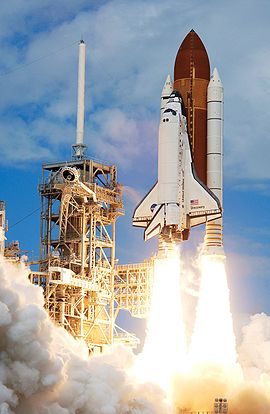.
Airborn... how that be? Don't want to take away the fun you'll have by proving me wrong, so go right ahead.
.
.
Rog-oh, going ahead.
<TABLE class="infobox hproduct" style="FONT-SIZE: 88%; WIDTH: 22em; TEXT-ALIGN: left"><CAPTION>
Saturn V</CAPTION><TBODY><TR><TD style="FONT-SIZE: smaller; TEXT-ALIGN: center" colSpan=2>

The first Saturn V, AS-501, before the launch of
Apollo 4
</TD></TR><TR><TH>Function</TH><TD>Manned
LEO and
Lunar launch vehicle</TD></TR><TR><TH>Manufacturer</TH><TD>
Boeing (
S-IC)
North American (
S-II)
Douglas (
S-IVB)
</TD></TR><TR><TH>Country of origin</TH><TD>
United States</TD></TR><TR><TH style="FONT-SIZE: 100%; TEXT-ALIGN: center" colSpan=2>Size</TH></TR><TR><TH>Height</TH><TD>363.0 feet (110.6 m)</TD></TR><TR><TH>Diameter</TH><TD>33.0 feet (10.1 m)</TD></TR><TR><TH>Mass</TH><TD>6,699,000 pounds (3,039,000 kg)</TD></TR><TR><TH>Stages</TH><TD>3</TD></TR><TR><TH style="FONT-SIZE: 100%; TEXT-ALIGN: center" colSpan=2>Capacity</TH></TR><TR><TH>
Payload to
LEO</TH><TD>262,000 pounds (119,000 kg)</TD></TR><TR><TD>
Payload to
Lunar vicinity
</TD><TD>(100,000 pounds (45,000 kg))</TD></TR><TR><TH style="FONT-SIZE: 100%; TEXT-ALIGN: center" colSpan=2>Associated rockets</TH></TR><TR><TH>Family</TH><TD>
Saturn</TD></TR><TR><TH>Derivatives</TH><TD>
Saturn INT-21</TD></TR><TR><TH>Comparable</TH><TD>
N1 rocket</TD></TR></TBODY></TABLE>
Specifications (An-225)
 Data from
Data from Vectorsite,<SUP class=reference id=cite_ref-goebel_1-3>
[2]</SUP> Antonov's Heavy Transports<SUP class=reference id=cite_ref-aht_22-0>
[23]</SUP>
<BIG>
General characteristics</BIG>
- Crew: 6
- Payload: 250,000 kg (550,000 lb)
- Door dimensions: 440 x 640 cm (14.4 x 21 ft)
- Length: 84 m (275.6 ft)
- Wingspan: 88.4 m (290 ft 2 in)
- Height: 18.1 m (59.3 ft)
- Wing area: 905 m<SUP>2</SUP> (9,743.7 ft<SUP>2</SUP>)
- Cargo Volume: 1,300 m<SUP>3</SUP> (46,000 cu ft))
- Empty weight: 285,000 kg (628,315 lb)
- Max takeoff weight: 640,000 kg<SUP class=reference id=cite_ref-Forward_8-1>[9]</SUP><SUP class=reference id=cite_ref-Spaeth_9-1>[10]</SUP><SUP class=reference id=cite_ref-Gordon_10-1>[11]</SUP> (1,323,000 lb)
- Powerplant: 6× ZMKB Progress D-18 turbofans, 229.5 kN (51,600 lbf) each
- Takeoff run: 3,500 m (11,500 ft) with maximum payload
<BIG>
Performance</BIG>
<TABLE class="infobox hproduct" style="FONT-SIZE: 88%; WIDTH: 22em; TEXT-ALIGN: left"><CAPTION>
Shuttle
</CAPTION><TBODY><TR><TD style="FONT-SIZE: smaller; TEXT-ALIGN: center" colSpan=2>

Space Shuttle
Discovery launches at the start of
STS-120.
</TD></TR><TR><TH>Function</TH><TD>Manned partially reusable launch and reentry system</TD></TR><TR><TH>Manufacturer</TH><TD>
United Space Alliance:
Thiokol/
Alliant Techsystems (SRBs)
Lockheed Martin (
Martin Marietta) – (ET)
Rockwell/
Boeing (orbiter)
</TD></TR><TR><TH>Country of origin</TH><TD>
USA</TD></TR><TR><TH style="FONT-SIZE: 100%; TEXT-ALIGN: center" colSpan=2>Size</TH></TR><TR><TH>Height</TH><TD>184 ft (56.1 m)</TD></TR><TR><TH>Diameter</TH><TD>28.5 ft (8.69 m)</TD></TR><TR><TH>Mass</TH><TD>4,470,000 lb (2,030 t)</TD></TR><TR><TH>Stages</TH><TD>2</TD></TR><TR><TH style="FONT-SIZE: 100%; TEXT-ALIGN: center" colSpan=2>Capacity</TH></TR><TR><TH>
Payload to
LEO</TH><TD>24,400 kg (53,600 lb)</TD></TR><TR><TH>Payload to
GTO
</TH><TD>3,810 kg (8,390 lb)</TD></TR><TR><TH style="FONT-SIZE: 100%; TEXT-ALIGN: center" colSpan=2>Launch history</TH></TR><TR><TH>Status</TH><TD>Active</TD></TR><TR><TH>Launch sites</TH><TD>
LC-39,
Kennedy Space Center
SLC-6,
Vandenberg AFB (unused)
</TD></TR><TR><TH>Total launches</TH><TD>130</TD></TR><TR><TH>Successes</TH><TD>129</TD></TR><TR><TH>Failures</TH><TD>1 (
launch failure,
Challenger)</TD></TR><TR><TH>Other</TH><TD>1 (
re-entry failure,
Columbia)</TD></TR><TR><TH>Maiden flight</TH><TD>April 12, 1981</TD></TR><TR><TH>Notable payloads</TH><TD>
Tracking and Data Relay Satellites
Spacelab
Great Observatories
Galileo
Magellan
Space Station components
</TD></TR><TR><TH style="FONT-SIZE: 100%; TEXT-ALIGN: center" colSpan=2>Boosters (Stage 0) -
Solid Rocket Boosters</TH></TR><TR><TH>N<SUP>o</SUP> boosters</TH><TD>2</TD></TR><TR><TH>Engines</TH><TD>1
solid</TD></TR><TR><TH>Thrust</TH><TD>2,800,000
lbf each,
sea level liftoff (12.5
MN)</TD></TR><TR><TH>
Specific impulse</TH><TD>269 s</TD></TR><TR><TH>Burn time</TH><TD>124 s</TD></TR><TR><TH>Fuel</TH><TD>solid</TD></TR><TR><TH style="FONT-SIZE: 100%; TEXT-ALIGN: center" colSpan=2>First stage -
External Tank</TH></TR><TR><TH>Engines</TH><TD>(none)
(3
SSMEs located on Orbiter)
</TD></TR><TR><TH>Thrust</TH><TD>1,225,704 lbf total, sea level liftoff (5.45220 MN)</TD></TR><TR><TH>
Specific impulse</TH><TD>455 s</TD></TR><TR><TH>Burn time</TH><TD>480 s</TD></TR><TR><TH>Fuel</TH><TD>
LOX/
LH2</TD></TR><TR><TH style="FONT-SIZE: 100%; TEXT-ALIGN: center" colSpan=2>Second stage -
Orbiter</TH></TR><TR><TH>Engines</TH><TD>2
OME</TD></TR><TR><TH>Thrust</TH><TD>53.4 kN combined total vacuum thrust (12,000 lbf)</TD></TR><TR><TH>
Specific impulse</TH><TD>316 s</TD></TR><TR><TH>Burn time</TH><TD>1250 s</TD></TR><TR><TH>Fuel</TH><TD>
MMH/
N<SUB>2</SUB>O<SUB>4</SUB></TD></TR></TBODY></TABLE>







